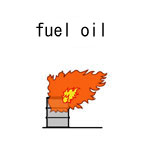| Case Name |
Fire caused due to erosion of a water injection nozzle to reactor outlet piping at a heavy oil hydrodesulfurization unit |
| Pictograph |

|
| Date |
May 22, 1988 |
| Place |
Iwakuni, Yamaguchi, Japan |
| Location |
Refinery |
| Overview |
At midnight, on May 22nd, 1988, the water injection piping installed in the feed/effluent heat exchanger tube outlet side piping of the fuel oil hydrodesulfurization unit got a hole, and internal fluid of the reaction system shot up, and ignited. The fire was controlled, and the remaining internal fluid was burned under controlled conditions. Improper water inlet shape and increase of the injection rate seemed to generate the erosion. |
| Incident |
A fire occurred at the heavy oil hydrodesulfurization unit of a petroleum refinery. The water injection nozzle to the heat exchanger outlet piping for heat recovery in the reactor downstream got a hole. High-temperature fluid of the reaction system (fuel oil, hydrogen sulfide and hydrogen) shot up. It came into contact with the air and ignited. There occurred a fire. Vacuum gas oil was hydrogenated, desulfurized, and cracked at this unit under a high-temperature and high-pressure (about 9MPa) hydrogen atmosphere. |
| Processing |
Manufacture |
| Individual Process |
Reaction |
| Process Flow |
Fig2.Unit process flow
|
| Chemical Reaction |
Other(hydro-desulfurization) |
| Substance |
Fuel oil |
| Type of Accident |
Leakage, fire |
| Sequence |
On May 22nd, 1988, at about 23:40: The water injection piping mounted in the heat exchanger outlet piping in the reactor downstream from the fuel oil hydrodesulfurization unit got a hole. Internal fluid of the reaction system shot up, and there occurred a fire.
On May 23rd, 00:50: The fire was controlled. Remaining internal fluid was burned.
01:38: Fire extinguishing was completed. |
| Cause |
1. It is presumed that the water injection nozzle to the reactor outlet piping was rapidly reduced in thickness by the interaction of erosion and corrosion, and a hole was generated.
2. It is assumed that ignition was caused due to discharge of static electricity because fluid containing a mist of heavy oil shot up. |
| Response |
The fire was controlled, and remaining internal fluid was burned under controlled conditions. |
| Countermeasures |
1. The following were carried out: Inspection of facilities and review of the inspection standard.
2. Shape and material of water injection piping was reviewed. |
| Knowledge Comment |
Un-burnt gas spreads in the air if a fire is extinguished, but a vapor cloud explosion can occur on igniting under such conditions. It is important to wait until the gas supply origin is intercepted or remaining gas is controlled and burned. |
| Background |
1. The shape of the injection nozzle was defective. 1-1/2 inches of piping is connected to the lower side of 3-inch piping, and sodium sulfate solution was sent from just under the piping. The hole opened just above the inlet piping.
2. Flow velocity seems to have been excessive compared to the designed velocity. This was caused by adhesion of scales to 1/2-inch piping and increase of the amount of injection water.
3. As the handled liquid was water, employees did not take care. |
| Reason for Adding to DB |
Example of accident caused due to erosion from improper shape of the water injection nozzle |
| Scenario |
| Primary Scenario
|
Poor Value Perception, Poor Safety Awareness, Insufficient Safety Measure, Ignorance, Insufficient Knowledge, Insufficient Past Information Collection, Planning and Design, Poor Planning, Poor Design, Bad Event, Thermo-Fluid Event, Erosion by Mixed Flow, Failure, Abrasion, Erosion, Secondary Damage, External Damage, Fire
|
|
| Sources |
High Pressure Gas Safety Inst. of Japan, High-pressure gas protection overview, pp.138-139(1989)
High Pressure Gas Safety Inst. of Japan, Heavy oil hydrodesulfurization equipment, Second Isomax process equipment fire, Accident examples of Petroleum refinery and Petrochemical units, pp.46-50(1995)
Hazardous materials safety research association of the Kawasaki City, Accident case, It is useful at present and at once. Examples of accidents at hazardous facilities. with FTA. pp.32-34(1997)
|
| Number of Injuries |
1 |
| Financial Cost |
¥ 500 thousand. (Accident examples of Petroleum refinery and Petrochemical units) |
| Notes |
The purpose of the water injection: As a result of the reaction, hydrogen sulfides, ammonia, very small amount of cyanogen, etc. are generated. To prevent corrosion by these materials or dirt, water or chemicals are injected when the operation temperature is lowered to the degree of the water stopping evaporation. |
| Field |
Chemicals and Plants
|
| Author |
OGAWA, Terushige (Graduate School of Environment and Information Sciences, Yokohama National University)
TAMURA, Masamitsu (Center for Risk Management and Safety Sciences, Yokohama National University)
|